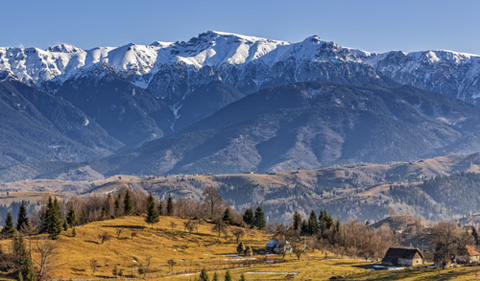
Countryside mountain landscape with ancient remote Romanian hamlet in the wide valleys of Bucegi mountains, Brasov county, Romania.
What do Athens, Ohio, and Brashov, Romania, have in common? They are both part of mountain ranges: The Appalachian Mountains in the United States, and the Carpathian Mountains in Eastern Europe.
In early October, Dr. Anna Rachel Terman traveled to the Appalachian Carpathian International Conference in Brashov, Romania, to compare the two regions and present her own findings.
Exchanging Ideas
“The idea of the conference is to gather a collection of scholars from the Appalachian region and the Carpathian region to compare the two cultures and the work that scholars are doing,” says Terman. “There were probably about 50/50 Americans and Romanians there, and there were also people from Ukraine and the UK in attendance.
“My work in sociology is based in Appalachia and my expertise is in Appalachian studies. I specifically study young people in Appalachia and what they’re doing in terms of participating in their communities and how they form an identity with place,” she says. Terman presented her paper, Intersecting Identities: Youth and Community Sustainability in the Appalachian Region of the United States alongside other scholars with similar foci. “Our session looked at the ways in which people’s identity, culture, and place influences their decision making and how they relate to their communities and their role in their communities,” she says.
Terman says the highlight of the trip was actually after the conference, where the presenters took a trip to Magura Village to learn about their school system and their agrarian lifestyle. “We stayed the night and visited a school while we were there and talked with the kids who were learning English,” she says. “The littlest kids in kindergarten would just say ‘Hello’ over and over because it was the only word they knew in English. It was very cute…. We brought them some school supplies and some children’s books about Appalachia.”
Appalachian vs. Carpathian Identity
While the two mountain ranges are thousands of miles apart, they still bear many similarities.
“A lot of times [mountain communities] will have a distinct culture, and people will [stereotype them] as being backwards and not as civilized and the rest of the country or culture,” Terman says. “That kind of stereotype is typical of a lot of other cultures as well. There are a lot of environmental similarities in terms of how people use natural resources. A lot of times mountain communities have a different development history because of the difficulty of building roads and access to those places. In many cases the wealth is not kept in those areas as well as it could be.”
So what about the differences?
“Because of the specific political history that Appalachia has had in our country and the fact that we have a federal entity that defines the boarders of Appalachia, and there’s been a lot of government assistance to the region over the years … there’s a kind of Appalachian identity that people have in this country that I didn’t notice as much in Romania,” says Terman. “This may be because the Carpathian Mountains span multiple countries, and therefore people may be more quick to identify with their country than with this large region.”
Romania isn’t the only place where conversations about mountain communities are taking place. “We have an Appalachian Studies Association conference [in the US] every year and [people from Ukraine and Romania] have come over for that conference,” she says. “It’s kind of an exchange that has been taking place between people studying in both regions…. This Appalachian Carpathian International Conference connection is sort of new, since this is the second time they’ve done it. I think the idea is to go to different countries in Eastern Europe. There’s talk of maybe going to Slovakia or Ukraine the next time.”
When asked about her interest in returning to the conference, Terman is enthusiastic.
“I’d definitely be interested in going back,” she says. “It’s just a wonderful opportunity to make connections between scholars in the U.S. and scholars in other countries that have some similar interests but don’t have a lot of platforms to exchange that kind of information.”
Intersecting Identities: Youth and Community Sustainability in the Appalachian Region of the United States
ABSTRACT: Community sustainability in the Appalachian region of the U.S., like in many rural communities in developed countries, is threatened by processes of deindustrialization, economic restructuring, and globalization. In the midst of these macroscopic social changes, young people in Appalachia are often compelled to leave the region for urban centers due to economic, social, and environmental concerns. However, there is also evidence of a growing movement of young people who are deeply invested in their Appalachian communities. At the same time, these young people negotiate a place identity that intersects with gender, race, class, and sexuality identities, which can seem at odds with the norms of their communities. Using qualitative data collected from interviews and focus groups with young people living in Appalachia, I will discuss the ways in which gender, race, class, and sexuality influence young adults’ place identity in Appalachia and their relationship to their community, environment, and region. My findings destabilize “metronormative” narratives that perpetuate the idea that young people, especially marginalized youth, should leave rural places for large urban centers and shines a light on the struggles and perseverance of youth in Appalachia as they confront questions of individual success and community well-being.




















Comments